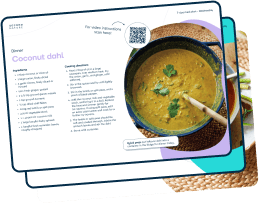Many of us want to start eating more balanced, healthy foods but are worried about the effect this might have on our supermarket bill.
There are many overpriced ‘superfoods’ that are marketed as being essential purchases for health, but often this isn’t the case. With adequate planning and preparation, you can enjoy varied and healthy meals at an affordable cost.
Out of context, whole food products, e.g spinach or cheese, seem more expensive than ultra-processed foods, e.g. chocolate bar multipacks or crisps. Cooking from scratch also requires more ingredients.
However, after the initial start-up cost of building your pantry and stocking the fridge, these ingredients generally last a long time, so it works out cheaper in the long run.
To break this down, a £3 meal deal sounds like great value at first glance; a total of three ready-made meals for £9 per day. But let’s compare this to a planned menu as below:
- Breakfast: Greek yoghurt and berries
- Lunch: Homemade vegetable frittata with salad
- Dinner: Baked white fish fillet and mixed vegetables (cooked from frozen)
While this would cost you around £17.50, the quantity of food purchased would last you for four days. Taking a closer look at the figures, when divided by 12 meals, the cost of each meal would be only £1.45. This is a savings of 50% when compared with the store-bought options. A meal prepared at home will also be more nutritious.
We asked a member of the Second Nature programme, Sara*, how her food shopping bill has reduced by £30-£40/week since buying more healthy, whole foods and fewer ultra-processed foods.
*Name has been anonymised
Medication-assisted weight loss with a future focus
Start with Wegovy or Mounjaro, transition to habit-based health with our support


What counts as ‘healthy eating’?
Before we move on to an example of reduced food bills on a healthier diet, it’s worth noting what ‘eating healthy’ actually means.
With so much conflicting advice around health and nutrition, it can be challenging to know what even counts as ‘healthy’. Plus, the healthiest diet for one individual might not be the best option for another.
The main point everyone agrees on is that a varied diet high in whole foods (e.g. fish, vegetables, or eggs) and low in ultra-processed foods (e.g. biscuits, crisps, or cakes) will benefit us.
For those of us with the primary goal of weight loss, science suggests that a lower carbohydrate approach is the most effective.
Meet the member
Sara, 44, is from Bournemouth and currently works as a Mortgage Underwriter/Case Owner. She lives with her two young children. Whilst working full-time, Sara is completing a qualification via self-study while working full-time. On average, Sara does one big food shop each week.
She has previously tried popular weight loss programmes, such as Slimming World, but found them difficult to sustain in the long term. Sara also noticed that popular weight loss programmes often encouraged buying branded products, which increased her food bill.
Since joining the Second Nature programme, Sara has saved £30-£40/week on her food bills. Second Nature is a habit change programme that helps you lose weight in 12 weeks.
Learning about the nutrition science behind healthy whole foods and building sustainable habits, such as meal planning and food prepping, is at the core of the programme.
Example shopping list
Below is an example shopping list that Sara has provided, which shows a typical weekly food shop before and after joining the Second Nature programme.
Note: This list includes what Sara buys for herself, not her children
| Before | After | |
| Food for meals | – Slimming World lasagnes – Slimming World curries – Slimming World ready meals – Slimming World chips – Slimming World side dishes – Baked beans – Fry light 1 calorie oil spray – Chicken breasts – Various fresh fruit and veg – Eggs – Microwave rice packets – Frozen baked potatoes – Tuna tins – Prawns – Mackerel tins – Smoked salmon (when on special offer) – Beef mince – Curry powder – Frozen veg – Tomato puree |
– Fruit and veg (more than previously) – Frozen fruit and veg (more than previously) – Avocados – Chicken breasts – Tofu – Falafel – Hummus – Olive oil (only occasionally as it lasts) – Curry paste (occasionally), – Tomato puree – Beef mince – Microwave rice packets – Small wholemeal bread loaf – Prawns – Smoked salmon (when on special offer) – Tinned tuna – Tinned mackerel |
| Food for snacks | – Low-calorie mini apple crumble – Diet fizzy drinks – Rice cakes – Low-calorie cereal – Cake bars – Flavoured Muller light yoghurts – Kit Kats multipack – Low-calorie hot chocolate |
– Cheese – Ham – Pistachios – Cashews – Full-fat natural probiotic yoghurt |
You can see from these shopping lists that Sara still buys foods she enjoys, but has cut out a lot of the ultra-processed and branded foods (e.g. Kit Kats and ready meals), in place of satisfying whole foods (e.g. nuts and falafel).
Often ultra-processed and branded foods can be the most expensive things on our shopping lists. Cooking our meals mostly from scratch usually works out to be cheaper than buying ready meals or pre-made foods.
Example meals
From Sara’s weekly shop, here is an example of what she might eat for meals and snacks on a normal day:
| Before | After | |
| Breakfast |
– Poached eggs + baked beans + toast
|
– Poached eggs + veg + small slice wholemeal toast |
| Lunch | – Chicken, cheese, and tomato sandwich + apple + low-fat crisps/cereal bar |
– Leftover curry from the previous evening meal OR – Tuna salad with lots of veg + 1/4 avocado + a dressing made from olive oil
|
| Dinner | – Curry, + veg, (made with fry light spray) + lots of rice. –OR– Slimming World ready meal + slimming world chips or a Slimming World side dishPudding:- Small apple crumble – Flavoured Muller light yoghurts |
– Curry + veg (made with olive oil) + small amount of rice if any
OR – Bolognese sauce + small amount of pasta if any Pudding: – Frozen fruit and plain yoghurt, if any |
| Snacks | – Kit Kat | – An apple with a piece of cheese
OR – A handful of nuts |
Since Sara has made her meals higher in protein and healthy fats and lower in carbohydrates (which gets broken down to glucose, a form of sugar), she feels more satisfied:
“I don’t eat anywhere near as many snacks or puddings as before because I don’t crave sweet stuff any more and the meals are a lot more satisfying. [This has] saved a lot of money because the Second Nature recipes are more filling and satisfying, so I don’t feel hungry between meals. I now don’t buy anywhere near as much snack food as I did before and I also end up eating less at mealtimes.”
Top tips to eat well for less
Sara has provided her top tips on how to keep costs low, while still eating a healthy, satisfying diet:
1) Look out for deals and offers
Non-perishable items (e.g. dry herbs, lentils, beans, tinned tomatoes) can be stored in a cupboard until you need them. For perishable items (e.g. fish, chicken, vegetables) consider buying them when they’re on offer and freezing them until you want to cook and eat them.
2) Meal planning
Making a meal plan for the week ahead means we only buy what we’re going to use, which prevents us from getting distracted in the supermarket, buying unnecessary things, and ending up wasting food.
3) Frozen fruit and veg
4) Be cautious about ‘best before’ dates
‘Best before’ dates, signalling when the food might taste it’s best, are different to ‘use by’ dates, which tell you when the food will most likely be off.
Usually, we can tell when fresh foods have gone off by the look, feel, and smell. Onions, for example, tend to last much longer than their ‘best before’ dates. Throwing away food unnecessarily will increase the cost of your food shop. With fresh meat or dairy, however, ‘use by’ dates should be followed.
5) Batch cook
Cooking in batches can save you both time and money. Freeze any leftovers to have for a quick meal at another time, or eat the leftovers the next day for lunch.
6) Check for cheaper brands
Cheaper brands of the same product are usually located high or low on the supermarket shelves, with the more expensive ones at eye level. Making a quick cost comparison in the supermarket may take a bit more time, but it will save you money at the check-out.
Here are some extra tips from the dietitians at Second Nature:
7) Use markets, fruit/vegetable stores, and local butchers
Fruit, vegetables, and meats are often marked up in supermarkets. Buying foods from your local farmers market or fruit shop can be a much cheaper way to shop. These foods are also often fresher, meaning they’ll last you longer. Take a look at this website to find your closest farmers markets.
8) Bulk out your meals with legumes, lentils, and vegetables
Vegetarian sources of protein are often cheaper than meat. Pulses, such as beans, lentils, and peas, are some of the most affordable foods on the supermarket shelf.
Try having a meat-free meal a few times a week, or use these in dishes to replace a portion of meat, e.g. chilli con Carne with kidney beans or chicken curry with chickpeas.
9) Buy whole chicken or cuts of meat
Pre-cut and packaged meats (such as sliced ham or chicken portions) are often more expensive. Instead, buy an entire chicken where you’ll get more meat and can use the carcass for making stock, or a whole joint of gammon. You can cook these, then slice and freeze in individual portions to have at another time.
You can also look for cheaper cuts of meat, which may take a little more time with cooking but are a great way to save money. For example, braising steak, shin, brisket, or shoulder can be slow-cooked to break down the fibres in cheaper cuts and make them more tender.
10) Buy seasonal fruit and vegetables
Fruits and vegetables that are in season are typically much cheaper. Before you plan your meals for the week, take a look at this seasonal calendar to help you determine what will be most cost-effective.


